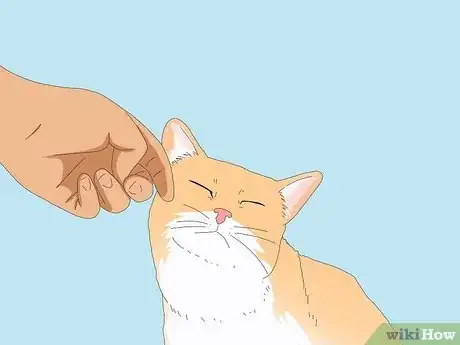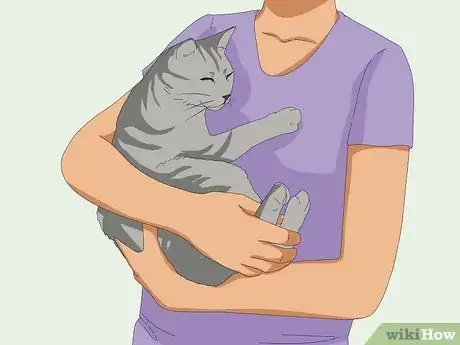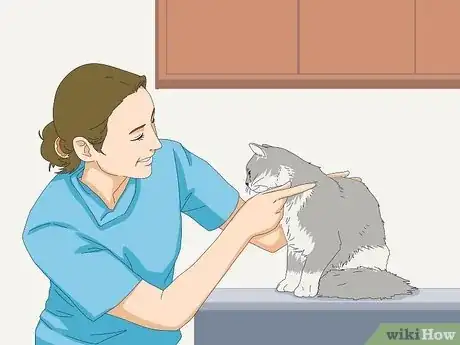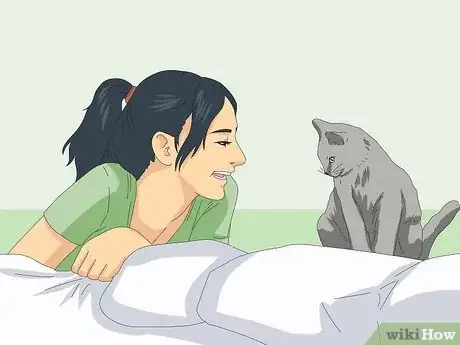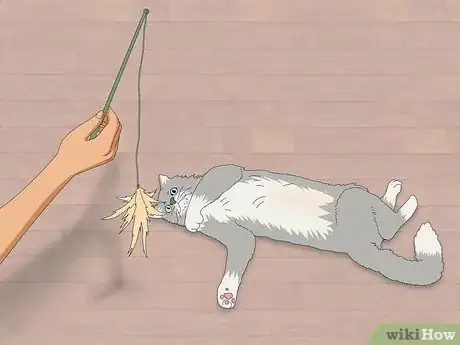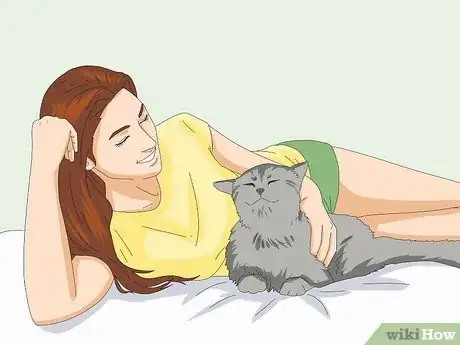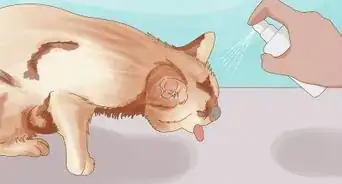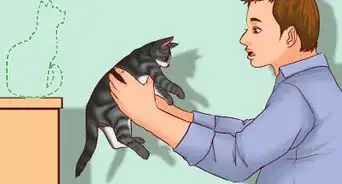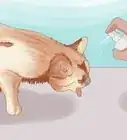This article was co-authored by Brian Bourquin, DVM. Brian Bourquin, better known as “Dr. B” to his clients, is a Veterinarian and the Owner of Boston Veterinary Clinic, a pet health care and veterinary clinic with three locations, South End/Bay Village, the Seaport, and Brookline, Massachusetts. Boston Veterinary Clinic specializes in primary veterinary care, including wellness and preventative care, sick and emergency care, soft-tissue surgery, dentistry. The clinic also provides specialty services in behavior, nutrition, and alternative pain management therapies using acupuncture, and therapeutic laser treatments. Boston Veterinary Clinic is an AAHA (American Animal Hospital Association) accredited hospital and Boston’s first Fear Free Certified Clinic. Brian has over 19 years of veterinary experience and earned his Doctor of Veterinary Medicine from Cornell University.
There are 14 references cited in this article, which can be found at the bottom of the page.
wikiHow marks an article as reader-approved once it receives enough positive feedback. This article received 13 testimonials and 100% of readers who voted found it helpful, earning it our reader-approved status.
This article has been viewed 296,327 times.
Cats can be difficult to bond with. Most are independent animals that don't need constant interaction with humans to be content. To strengthen your relationship with your cat, you will also need to create a safe, positive environment for it. You'll also need to teach the cat to associate you with things it already likes, such as food. Whether your cat it young or old, you can build a great relationship with it with a little work and patience.
Steps
Socializing a New Cat
-
1Socialize your cat as early as possible. To build a strong relationship with a cat, you must first ensure that it is comfortable with people in general. Socializing young kittens is important for their future relationships with people.
- Socialization with people between 2 and 7 weeks of age sets the stage for the rest of the cat’s life.[1]
- Socialization includes holding the kitten and encouraging it to interact with people and animals. These interactions need to be pleasant for the cat to want to continue them in the future.[2]
- Consider kitten socialization classes. Your veterinarian likely has some resources for you to consider.[3]
-
2Be patient with older cats. If you have an older cat, great news for you! You can still work with it. Positive interactions go a long way at all ages to befriend a cat.
- Even a cat that has been feral (living wild, without people) for up to four years can be socialized.[4]
- Depending on the cat, socializing an older cat could take more time. The steps described in this article still apply. If the cat is used to living with humans it will crave your attention, and usually ease into a routine.
Advertisement -
3Create a comfortable environment for the cat. A cat won’t want to socialize if it doesn’t feel comfortable and safe. Create a calm and non-threatening environment when introducing a new cat to your home.
- Begin by putting it in a quiet room where it can get comfortable in the space. Your bedroom is a good choice. Spending time here will help your cat get used to your scent.[5] Gradually allow the cat to explore more of the environment as it becomes more comfortable.
- Give the cat comfortable and fun surfaces to lay on (and in). A cat tree can be great for a cat that needs a little security and a place to call their own.
- The cat should have access to food, water, a litter box, and a scratching post.[6]
-
4Keep a respectful distance. Don’t hover over or crowd the cat. By staying calm and keeping your distance, you’re showing the cat you aren’t a threat and it shouldn’t fear you.
- This is especially important for older cats that are not used to spending time around people. Giving a cat like this too much attention will actually do more harm than good. You must let a cat like this come to you.
- Sit and read or watch TV, ignoring the cat. Scatter treats or the cat’s food around the room and encourage the cat to hang out and hunt for food.[7] The cat will follow the treats and slowly get closer to you. Stay still. Don’t reach out or talk to the kitty at first. Let them get used to hanging out in the same room. The food is creating a positive association with you being nearby.
- Let the cat come to you. Dangle or toss a toy to make yourself more interesting. Don’t try to pet the cat right away, as you may scare it. Let your presence be non-threatening at first, then work up to petting the cat, even one pet at a time. Don’t push it, or you will need to start over winning your cat’s trust.[8]
- Remember that it may take awhile for your cat to know that you do not intend to harm it. It doesn't know you yet. Show it your love by being patient when it is new to your home.
-
5Use a pheromone diffuser to calm a scared cat. These diffusers contain a calming cat pheromone that can help an anxious cat feel comfortable and relaxed.
- Pheromone diffusers are very simple to use. All you have to do is plug them into a wall outlet, like many commercial air-freshening products. Then, just check them periodically to ensure they haven't run out of liquid.
- You can find these diffusers at most pet and online retailers.
-
6Pet the cat gently when it invites you to. Cats are easily over-stimulated, and a cat will become anxious or defensive if you try to show it affection when it isn’t welcome. Make sure the cat associates you with wanted, gentle affection, not anxiety.
- Gently pet the cat if it rubs against you. When your cat rubs itself on your body, that is a friendly gesture. Reinforce the connection it is making with you by taking the opportunity to pet.
- Cats like to have their heads and necks scratched. They also like gentle pets on the back, right where the spine meets the tail.[9] Full-back strokes can be overstimulating and cause a cat distress to the point it may claw or bite you.
- Offering a treat after handling your cat helps it create a positive association with touch.[10]
-
7Pick up your cat when it is relaxed. Pet the cat as long as it seems to enjoy it, and then pick it up and deliver it to a nice sunny spot or to food. You are trying to create the idea that being picked up is a good thing.
- Make sure you're fully supporting your cat's weight when you pick it up.[11]
- Don't forcibly hold a cat that doesn't want you to. This could break the trust you have built up with them. This is especially crucial for older cats.
- There are times when you will need to pick up your cat against its will, for instance when you need to put it in a carrier. Be sure to do this as gently as possible, making sure to calm the cat with a nice tone of voice, petting, and perhaps even treats.
- Children should always be supervised when handling a cat. It's a good idea to have children sit down before they hold your cat so there's no risk of them accidentally dropping it.[12]
-
8Seek veterinary intervention if all else fails. Fearful and anxious adult cats may need prescription medication to help the socialization process. Talk to your veterinarian if the suggestions above don't seem to work.[13]
- There are veterinary behavior specialists that may be able to help in extreme cases. Ask your regular vet for a referral.
Building a Positive Relationship With Your Cat
-
1Make sure you are the one feeding the cat. Once your cat is comfortable with your presence, you can start building a positive relationship. Food is a powerful motivator, and you want to be the person your cat associates with food. This will help your cat associate something positive to your presence.
- Feed your cat two or three small meals a day, rather than leaving food out. That will reinforce the association between you and food. If you leave dry food out for your cat, you can still use small meals of wet food in this way.
- Stay in the room while your cat eats, to help strengthen the association between you and the food. You can also pet the cat while it eats.
- Feeding high-value treats will also reinforce that you are the provider of all things good and tasty. Use the treats to reinforce good behavior, such as if the cat rubs up against your leg or shows you affection.[14]
-
2Make sure your cat is spayed or neutered. It will be easier for a cat to bond with you if it isn’t driven by the instinct to mate with other cats.[15]
- Spaying and neutering is also important to limit cat populations. This is especially important if your cat will live partially outdoors.[16] If your cat is not spayed or neutered, contact a veterinary clinic or your local humane society to set up an appointment.
-
3Speak to your cat. Talk to your cat often, using a calm and non-threatening tone.[17] Your tone of voice, along with your body language, conveys a message. Make sure that message is kind and gentle.
- Yelling at a cat (or any animal for that matter) will frighten it and cause it to distrust you. Even if your cat has misbehaved, try not to shout at it.
-
4Play with your cat. Once the cat feels comfortable approaching you, dangle a toy or string to invite the cat to play. Your cat may not want to play with you all the time, so take the opportunity when it does to bond with your pet.
- Cats love to play with tiny, fast-moving toys.[18]
- Many cats like catnip. Consider buying a toy that contains the herb to encourage play.[19]
- Playing with your cat will be most successful when the cat invites you to interact with it. For example, it may rub up against you or climb on you. While you can sometimes entice a cat to play with a flashy toy or a dangling string, your cat may ignore you if it doesn't want to play.
-
5Keep your cat, and its litter box, clean. Cats need a clean coat and clean surroundings to be content. Clean out it's litter box regularly, so it does not have to use filthy litter. A dirty litter box will often make a cat anxious and unhappy, leading it to act out.
- While your cat will probably spend a lot of time grooming, you may want to groom it yourself to bond with it. Try brushing the animal with a brush made for cats. Some cats will not allow you to, but others will enjoy the sensation. This will have the added benefit of lessening the cat fur in your house, especially if your cat is a long-haired breed.[20]
-
6Keep your cat healthy. A cat may become withdrawn or avoidant if it has unaddressed health issues. Make sure to take you cat in for regular veterinary check-ups. Contact the vet if you notice significant changes in your cat’s health or behavior.
- Your cat will not know that you are looking out for its well-being by taking it for check-ups. But, keeping it healthy is actually the best way for you to express your affection.
- The cat may not show you love while you are putting it in a cat carrier, but the healthy years you get to spend together should more than make up for that.
- Changes in your cat's normal behavior, like a sudden lack of appetite or bathroom issues, could be a sign that something is wrong.[21]
-
7Recognize the signs of affection. Everybody knows that purring is a sign of a contented cat. You may not know that a slow blink from your cat is also a sign of contentment and acceptance.
Expert Q&A
Did you know you can get expert answers for this article?
Unlock expert answers by supporting wikiHow
-
QuestionHow can I tell if my cat is stressed out?
 Brian Bourquin, DVMBrian Bourquin, better known as “Dr. B” to his clients, is a Veterinarian and the Owner of Boston Veterinary Clinic, a pet health care and veterinary clinic with three locations, South End/Bay Village, the Seaport, and Brookline, Massachusetts. Boston Veterinary Clinic specializes in primary veterinary care, including wellness and preventative care, sick and emergency care, soft-tissue surgery, dentistry. The clinic also provides specialty services in behavior, nutrition, and alternative pain management therapies using acupuncture, and therapeutic laser treatments. Boston Veterinary Clinic is an AAHA (American Animal Hospital Association) accredited hospital and Boston’s first Fear Free Certified Clinic. Brian has over 19 years of veterinary experience and earned his Doctor of Veterinary Medicine from Cornell University.
Brian Bourquin, DVMBrian Bourquin, better known as “Dr. B” to his clients, is a Veterinarian and the Owner of Boston Veterinary Clinic, a pet health care and veterinary clinic with three locations, South End/Bay Village, the Seaport, and Brookline, Massachusetts. Boston Veterinary Clinic specializes in primary veterinary care, including wellness and preventative care, sick and emergency care, soft-tissue surgery, dentistry. The clinic also provides specialty services in behavior, nutrition, and alternative pain management therapies using acupuncture, and therapeutic laser treatments. Boston Veterinary Clinic is an AAHA (American Animal Hospital Association) accredited hospital and Boston’s first Fear Free Certified Clinic. Brian has over 19 years of veterinary experience and earned his Doctor of Veterinary Medicine from Cornell University.
Veterinarian Look for changes in your cat's behavior. For example, your cat going to the bathroom outside of the litter box is a telltale sign that it's not happy. If your cat isn't eating, that could be a sign of something serious. If it becomes more attention-seeking or suddenly doesn't want any attention, that could also be a sign. Basically, anything that isn't the status quo is a red flag.
Look for changes in your cat's behavior. For example, your cat going to the bathroom outside of the litter box is a telltale sign that it's not happy. If your cat isn't eating, that could be a sign of something serious. If it becomes more attention-seeking or suddenly doesn't want any attention, that could also be a sign. Basically, anything that isn't the status quo is a red flag. -
QuestionMy new cat only plays with me sometimes and doesn't love me. What can I do?
 Pippa Elliott, MRCVSDr. Elliott, BVMS, MRCVS is a veterinarian with over 30 years of experience in veterinary surgery and companion animal practice. She graduated from the University of Glasgow in 1987 with a degree in veterinary medicine and surgery. She has worked at the same animal clinic in her hometown for over 20 years.
Pippa Elliott, MRCVSDr. Elliott, BVMS, MRCVS is a veterinarian with over 30 years of experience in veterinary surgery and companion animal practice. She graduated from the University of Glasgow in 1987 with a degree in veterinary medicine and surgery. She has worked at the same animal clinic in her hometown for over 20 years.
Veterinarian The fact that she plays with you is encouraging. Aim to play with her for short time periods several times a day so that she associates you with fun. Keep some treats in a small pouch in your pocket, and drop the occasional treat as you walk along, which will help to entice her closer. When she starts to ask for more treats, make a fuss of her, and gradually she will become more affectionate.
The fact that she plays with you is encouraging. Aim to play with her for short time periods several times a day so that she associates you with fun. Keep some treats in a small pouch in your pocket, and drop the occasional treat as you walk along, which will help to entice her closer. When she starts to ask for more treats, make a fuss of her, and gradually she will become more affectionate. -
QuestionHow do you make a street cat love you?
 Pippa Elliott, MRCVSDr. Elliott, BVMS, MRCVS is a veterinarian with over 30 years of experience in veterinary surgery and companion animal practice. She graduated from the University of Glasgow in 1987 with a degree in veterinary medicine and surgery. She has worked at the same animal clinic in her hometown for over 20 years.
Pippa Elliott, MRCVSDr. Elliott, BVMS, MRCVS is a veterinarian with over 30 years of experience in veterinary surgery and companion animal practice. She graduated from the University of Glasgow in 1987 with a degree in veterinary medicine and surgery. She has worked at the same animal clinic in her hometown for over 20 years.
Veterinarian Street cats are likely to be fearful of people, anxious, and keen to keep their distance. Try to win her confidence by feeding her regularly, so that she associates your presence with security and good things. Step a little closer each time so she grows used to your presence. Wait for her to come to you to be petted, rather than approaching her. Be prepared to be patient!
Street cats are likely to be fearful of people, anxious, and keen to keep their distance. Try to win her confidence by feeding her regularly, so that she associates your presence with security and good things. Step a little closer each time so she grows used to your presence. Wait for her to come to you to be petted, rather than approaching her. Be prepared to be patient!
References
- ↑ http://www.aspca.org/pet-care/virtual-pet-behaviorist/cat-behavior/socializing-your-kitten
- ↑ https://www.aspca.org/pet-care/virtual-pet-behaviorist/cat-behavior/socializing-your-kitten
- ↑ http://www.aspca.org/pet-care/virtual-pet-behaviorist/cat-behavior/socializing-your-kitten
- ↑ http://www.straypetadvocacy.org/feral_animals.html
- ↑ http://cattime.com/helping-your-shy-cat-feel-more-comfortable.html
- ↑ http://www.humanesociety.org/animals/cats/tips/bringing_new_cat_home.html
- ↑ http://pets.webmd.com/cats/features/how-to-bond-with-a-cat
- ↑ http://pets.webmd.com/cats/features/how-to-bond-with-a-cat
- ↑ http://www.perfectpaws.com/handle.html#.VUkjG5NcKT8
- ↑ http://www.perfectpaws.com/handle.html#.VUkjG5NcKT8
- ↑ Brian Bourquin, DVM. Veterinarian. Expert Interview. 31 January 2020.
- ↑ Brian Bourquin, DVM. Veterinarian. Expert Interview. 31 January 2020.
- ↑ http://www.petmd.com/cat/conditions/behavioral/c_ct_fear_phobia_anxiety?page=2
- ↑ http://pets.webmd.com/cats/guide/kitten-training-tips
- ↑ http://pets.webmd.com/cats/features/how-to-bond-with-a-cat
- ↑ http://www.humanesociety.org/issues/pet_overpopulation/facts/why_spay_neuter.html
- ↑ https://www.petcentric.com/07-21-2009/talking-to-your-pets
- ↑ Brian Bourquin, DVM. Veterinarian. Expert Interview. 31 January 2020.
- ↑ http://pets.webmd.com/cats/features/how-to-bond-with-a-cat
- ↑ http://www.knowyourcat.info/info/catbrushing.htm
- ↑ Brian Bourquin, DVM. Veterinarian. Expert Interview. 31 January 2020.
- ↑ http://www.catbehaviorassociates.com/cat-kisses/
- ↑ Brian Bourquin, DVM. Veterinarian. Expert Interview. 31 January 2020.
- ↑ http://www.straypetadvocacy.org/feral_animals.html
About This Article
To get your cat to know and love you, give your cat several small meals and treats every day so it starts to associate you with food and rewards. Also, spend a lot of time playing with your cat, which will help it bond with you. Don't try to force your cat to spend time with you or give you attention or you might scare it away. Instead, be patient and wait for your cat to come to you on its own time. If your cat is scared all the time, set up a cat pheromone diffuser to help it feel calm and relaxed around you. To learn how to tell if your cat loves you, scroll down!





